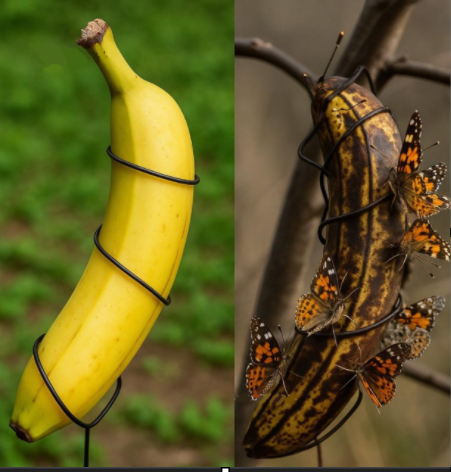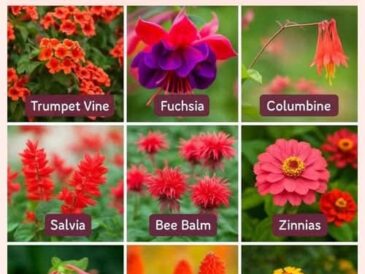In a world where urbanization, climate change, and pesticide use threaten the habitats and food sources of countless wildlife species, small acts of kindness can make a big difference. If you are a garden lover or simply someone who enjoys connecting with nature, one simple but incredibly effective way to support butterflies and other pollinators in your backyard or community green spaces is by using a banana hanger. This humble device, easy to make and maintain, can attract butterflies, bees, hummingbirds, and other beneficial insects by offering them a natural, energy-rich food source.
This article will explore in detail the importance of feeding butterflies and pollinators, the biology of their feeding preferences, the materials and step-by-step instructions for making a banana hanger, and the broader ecological benefits that such a simple act of kindness can bring to your garden and the environment.
Why Feeding Butterflies and Pollinators Matters
The Decline of Pollinator Populations
Pollinators like butterflies, bees, hummingbirds, and even certain beetles and flies play a crucial role in our ecosystem by enabling the reproduction of many plants, including most fruits, vegetables, and flowers. Yet, studies over the past decades have revealed alarming declines in pollinator populations worldwide. Habitat destruction, pesticide use, climate change, and diseases are primary factors driving these declines.
Butterflies, for instance, serve as important indicators of environmental health. Because of their sensitivity to changes in habitat quality and climate, a drop in their numbers often signals broader ecosystem problems. Protecting and supporting these species is therefore vital for biodiversity conservation and food security.
Butterflies’ Role Beyond Pollination
While butterflies are best known for their pollination, they also contribute to the food web by serving as prey for birds, bats, and other wildlife. By helping feed butterflies and increase their populations, you are indirectly supporting other creatures higher up the food chain, contributing to a balanced and healthy ecosystem.
The Challenge: Finding Food Sources
Butterflies primarily feed on nectar from flowers. However, nectar availability can vary with season, weather, and plant diversity. Additionally, many butterfly species supplement their diet with overripe or rotting fruits, which provide essential sugars, minerals, and nutrients not found in nectar alone. In urban or suburban environments where natural food sources might be limited, providing alternative feeding sites becomes critical.
Understanding Butterfly Feeding Behavior
What Do Butterflies Eat?
Butterflies primarily consume:
- Nectar: From flowers, rich in sugars.
- Rotting Fruit: Overripe or fermenting fruits like bananas, oranges, and mangoes.
- Minerals and Salts: Often from mud puddles or sweat on skin.
- Tree Sap and Animal Droppings: Sources of nutrients and minerals.
Rotting or overripe fruit is particularly attractive because it ferments, releasing sugars and sometimes alcohol, which many butterflies find irresistible. Bananas are one of the most popular fruits among butterflies due to their sweetness and softness.
How Butterflies Feed on Fruit
Butterflies have a proboscis, a long tubular tongue, which they uncoil to suck up liquids. When feeding on fruit, they extend this proboscis to lap up the sugary juices oozing from the fruit surface. Soft, ripe bananas are especially easy for them to access and are often preferred.
Other Beneficial Visitors to Fruit Feeders
In addition to butterflies, fruit feeders attract:
- Bees: Important pollinators.
- Hummingbirds: Drawn by the sweet juice.
- Other Insects: Such as ants and certain beetles, which contribute to the garden ecosystem.
How to Make a Banana Hanger: Materials and Step-by-Step Instructions
Creating a banana hanger is straightforward and requires minimal materials, all of which are typically easy to find or already available at home.
Materials Needed
- Banana(s): Preferably ripe or overripe.
- String or Twine: Natural fibers like jute or cotton are ideal, but any durable string works.
- Branch or Hook: To hang the banana in your garden.
Step-by-Step Instructions
Step 1: Choose the Banana
Select bananas that are ripe or slightly overripe, as these are the most attractive to butterflies. The peel can be partially or fully removed, depending on your preference. Removing some peel exposes more of the soft fruit flesh, making it easier for butterflies to feed.
Step 2: Tie the String Around the Banana
Tie a secure loop or knot around the stem or the top part of the banana peel. Ensure the knot is tight enough to support the weight of the banana and to prevent it from slipping off.
Step 3: Select a Location to Hang the Banana
Find a sunny spot in your garden, ideally near flowering plants or where butterflies are commonly seen. A sturdy tree branch, garden hook, or even a shepherd’s hook can serve as a hanging point.
Step 4: Hang the Banana
Using the tied string, suspend the banana from the selected branch or hook. Make sure it hangs freely so insects can access it from all sides.
Step 5: Monitor and Replenish
Check the banana daily. As it becomes too soft or moldy, remove and replace with a fresh banana to maintain an attractive feeding site.
Enhancing Your Banana Hanger Setup for Maximum Attraction
Additional Tips
- Add Other Fruits: Butterflies also enjoy oranges, mangoes, and apples. Rotate or mix fruits to increase diversity.
- Keep It Clean: Remove old fruit regularly to prevent unwanted pests like wasps or rodents.
- Provide Water Sources: Butterflies need water and minerals; consider adding a shallow water dish with wet sand nearby.
- Include Native Flowering Plants: Complement fruit feeders with nectar-rich flowers to attract and nourish butterflies throughout their life cycle.
DIY Variations
- Fruit Skewers: Use a skewer to thread small pieces of fruit and hang it.
- Fruit Bowls: Place overripe fruit in a shallow dish outside but elevated from the ground.
- Mesh Bags: Place fruit in a breathable mesh bag and hang it to prevent pieces from falling.
Why This Simple Act of Kindness Benefits Your Garden and the Environment
Supporting Pollination and Biodiversity
Attracting butterflies and other pollinators boosts the pollination of flowers, vegetables, and fruits in your garden. This leads to:
- Increased plant health and productivity.
- Greater biodiversity with more insects, birds, and wildlife visiting your space.
- Reduced need for chemical fertilizers and pesticides.
Education and Connection with Nature
Watching butterflies feed is not only relaxing but educational. It offers a chance for children and adults alike to learn about life cycles, insect behavior, and the importance of ecological balance.
Aesthetic and Emotional Benefits
Butterflies add beauty and tranquility to any garden. Their colorful wings and graceful flight create a soothing atmosphere that can reduce stress and encourage mindfulness.
Frequently Asked Questions About Feeding Butterflies with Bananas
Can feeding bananas harm butterflies or other insects?
When done responsibly, feeding ripe bananas poses no harm. Avoid moldy or spoiled fruit that can harbor harmful bacteria or fungi.
How often should I replace the banana?
Replace it every 2-3 days or when it becomes too mushy or moldy.
Will this attract unwanted pests?
Possibly. Wasps, ants, or small mammals may also be attracted. Using mesh bags or fruit skewers can minimize this.
Can I feed butterflies year-round?
Butterflies are mostly active in warmer months, but this depends on your region’s climate.
Beyond the Banana Hanger: Other Ways to Support Butterflies
- Plant Butterfly-Friendly Gardens: Include native flowering plants that provide nectar and larval host plants for caterpillars.
- Avoid Pesticides: These chemicals kill beneficial insects and degrade habitats.
- Create Shelter Areas: Tall grasses, shrubs, and brush piles offer resting and breeding places.
- Provide Mud Puddles: Butterflies extract minerals from damp soil, an activity called ‘puddling’.
Final Thoughts: The Power of Small Actions
The banana hanger method is a testament to how simple actions can create positive ripples in the environment. By offering a modest food source, you foster the survival and thriving of butterflies and other pollinators. This not only benefits your garden but contributes to broader efforts in conservation and biodiversity preservation.
If every garden enthusiast, homeowner, or community space invested in such simple kindnesses, the collective impact could be monumental in reversing pollinator declines.
So, gather your bananas, tie your strings, and hang them proudly. Watch as your garden transforms into a lively haven buzzing with life and color.




